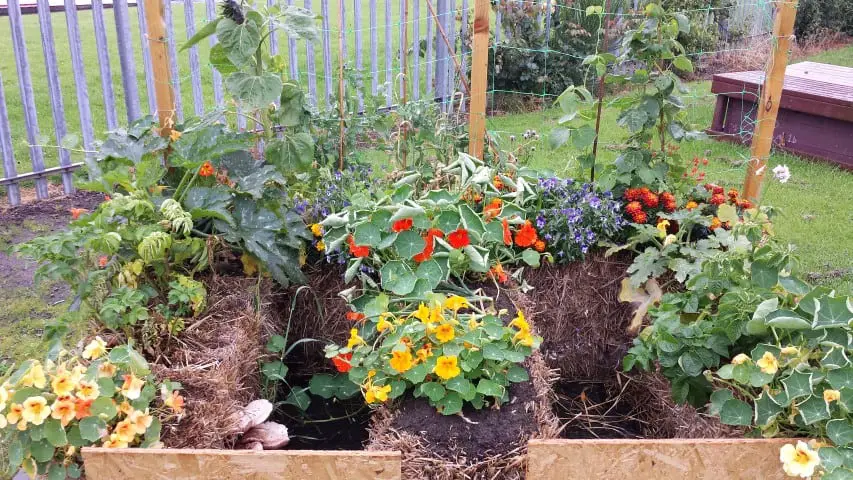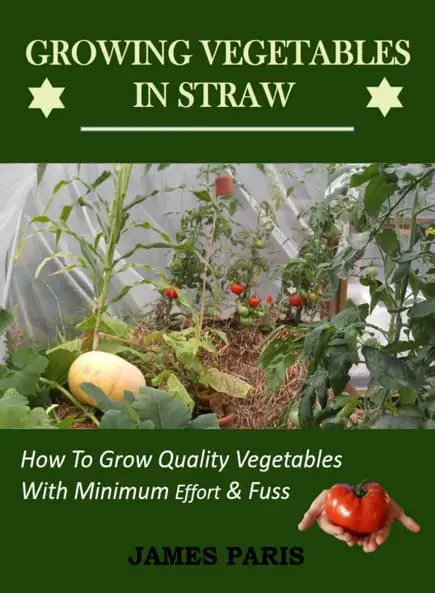Can you grow strawberries in straw bales? Yes of course you can – and it’s not difficult!
Straw bale gardening is an extremely effective ‘no-dig gardening’ way to grow all sorts of fruits and vegetables, and can be a great way to introduce gardening to the kids especially!
My wife is a nursery nurse at the local school, and I know from experience that the kids love this method because in practical terms it is at just about the perfect height for them.
But it’s not just the kids who love straw bale gardening, as I can testify! Having grown my own vegetables for over 40 years, I was only recently introduced to this method and have to say that for many different plants it can be very effective.
I have found that Strawberries for instance, grow very well in straw bales but only if the proper preparation of the bale is done beforehand (more on conditioning a straw bale on this post).

How to plant strawberries in straw bales
Planting the strawberries in the straw bale itself is surely an exercise in simplicity. Pull out a pot-sized hole in the top of the bale.
Fill in the hole (6 inch deep x 8 inch wide) with a good compost mix by poking the compost into the straw as you do this to make sure you have a good plug of compost.
Plant your strawberries as you would normally and soak the bale thoroughly afterwards.
That’s all there is to it – now you have to maximise your chances of having a good harvest.
Fertilizing your straw bale garden
In theory at least, if you have followed the correct procedure for conditioning your bale (as in the link above), there is nothing more to be done regarding feeding the plant other than regular watering.
You will find that the conditioning process for straw bale gardening involves a lot of nitrogen-rich fertilizer to get the composting process within the bale started. This composting bale is what feeds your plants over the growing season.
However, I usually find that if I do not add an additional feed then my plants will go weak with yellow/purple leaves and produce a thin crop.
then my plants will go weak with yellow/purple leaves and produce a thin crop.
I have solved this problem the organic way by feeding regularly – twice per week – with an organic ‘tea’ made from Russian comfrey soaked in a water barrel.
soaked in a water barrel.
This creates excellent plant food for all vegetables and especially fruiting plants like strawberries and tomatoes.
Russian comfrey is packed full of Calcium, Potassium, Phosphorus, Nitrogen, Iron, Iodine and many other minerals that fruit & vegetable plants thrive on.
This makes comfrey my go-to plant food store throughout the growing season. For this reason I have a large patch of Russian comfrey growing close to hand for harvesting.
Just one more thing about the Russian comfrey though – it is a VERY invasive plant and will grow wherever it can get the opportunity to set down roots.
For this reason alone, if you put Comfrey on the compost heap (which is an excellent use for it by the way), be sure it does not have any roots attached unless you want it to take over the compost!

 , means that you can grow strawberries for up to 4 years if you top off the bales with compost in the later years.
, means that you can grow strawberries for up to 4 years if you top off the bales with compost in the later years.Problems with growing strawberries in straw bales:
One of the ‘big issues’ with straw bale gardening is the short lifespan of the straw bale.
Basically you will only get 1 or 2 seasons from the bale before it all falls apart. For the strawberry gardener this immediately poses a problem because the on-going nature of strawberries demands that the second year is the most productive after which rotational cropping or planting of the runners comes into play.
Thankfully, there is a solution to this issue, and that is to surround your straw bales in a wooden frame – like the one you will see in the image on this page.
By surrounding your straw bales in this way you can extend the life of the bale for 3 years or more. After which you just keep topping off with compost and continue the process.
How many strawberry plants to a straw bale:
You can plant as many as 4 strawberry plants to a bale, but I usually plant only 2 per bale just to allow room for growth over 3 or 4 seasons.
Normally I place 4 bales in a timber frame like the one shown, which means I can plant out 8 plants altogether. This gives me all the strawberries I need over the season.
like the one shown, which means I can plant out 8 plants altogether. This gives me all the strawberries I need over the season.
I can also mix with early season, mid-season, and late season strawberry plants to be sure the strawberries keep coming throughout the summer!
Advantages of growing strawberries in straw bales:
Another problem with growing strawberries in general, is damage by slugs, and damage caused by them laying on wet soil – this is quite apart from predation by birds and critters that love strawberries!
As most gardeners will know, strawberries have to be kept off the wet ground to prevent them rotting, or becoming the target of slugs. This is normally achieved by laying out a bed of straw under the fruit.
By growing them on straw bales you solve at least 2 of these problems.
The fruit is already on the straw, which keeps them dry. It also means that they are not such an easy target for slugs who do not like the spiky stems of straw so much.
It’s a win-win situation really for growing strawberries in straw bales.
This straw bale garden method can also be extremely successful for a whole range of vegetable plants including carrots, onions, peas, zucchini, and even potatoes!
Summary:
By using the straw bale method to grow strawberries I have found that they are just easier to tend to, and cleaner to harvest without having to mess around packing straw under each individual plant in a traditional strawberry patch.
Provided the straw bales are properly conditioned with fertilizer at the beginning, and fed throughout preferably, I personally love to grow strawberries this way or indeed in a Hugelkultur, and would hate to resort to the traditional methods.
at the beginning, and fed throughout preferably, I personally love to grow strawberries this way or indeed in a Hugelkultur, and would hate to resort to the traditional methods.
However, another way that I have grown strawberries very successfully, is in a Hugelkultur strawberry bed. You can check it out on this post for more info.
If you have lots of spare forest cuttings and mulching material a Hugelbed could be the strawberry growing method for you!


